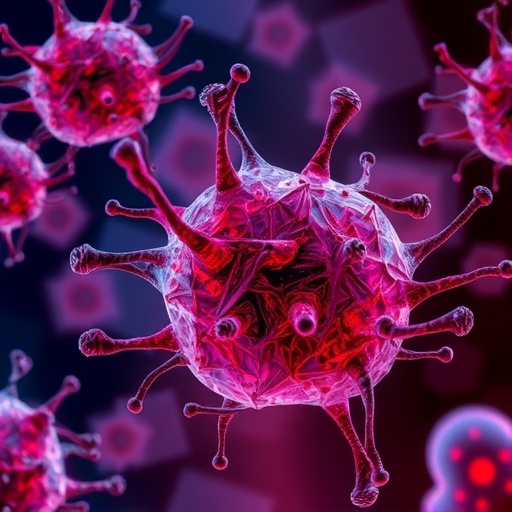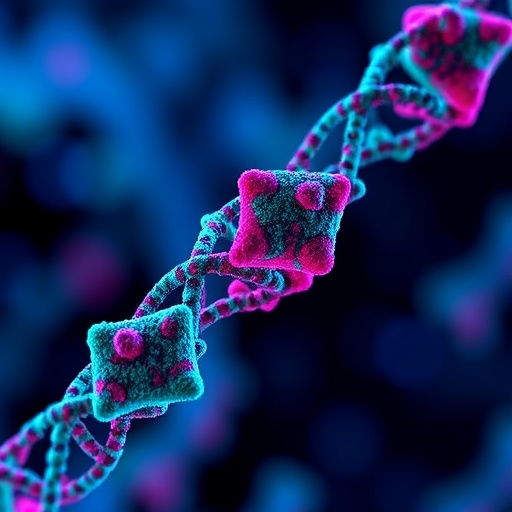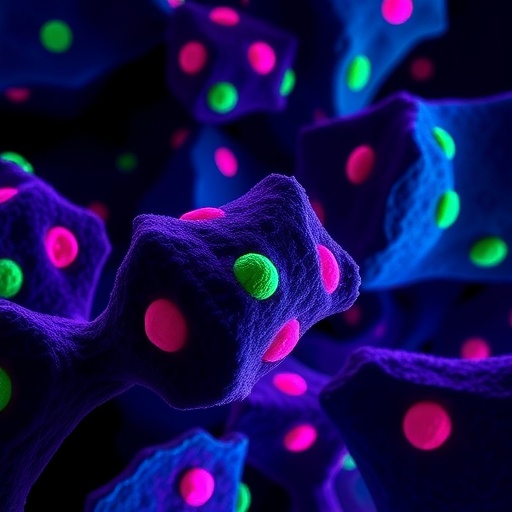Cancer cells continuously battle cellular stress through adaptive mechanisms, and among these, the unfolded protein response (UPR) plays a pivotal role in maintaining their survival. The UPR is a sophisticated cellular stress response activated upon the accumulation of misfolded or unfolded proteins within the endoplasmic reticulum (ER), the principal organelle responsible for protein folding and processing. When this protein homeostasis is disrupted, cells trigger the UPR to restore balance, activating a network of signaling pathways that enhance protein folding capacity, attenuate global protein synthesis, and degrade misfolded proteins. This finely tuned response ensures cell viability under stress conditions but is often exploited by cancer cells to thrive in hostile environments.
Within the machinery of the UPR, inositol-requiring enzyme 1 (IRE1) stands as a critical transducer. IRE1 is an ER-transmembrane protein endowed with dual enzymatic functions: kinase and endoribonuclease (RNase) activities. Upon sensing ER stress, IRE1 oligomerizes and autophosphorylates via its kinase domain, thereby activating its RNase domain. This RNase activity initiates the unconventional splicing of X-box binding protein 1 (XBP1) mRNA, resulting in the production of a potent transcription factor that upregulates genes involved in protein folding, secretion, and degradation pathways. Consequently, IRE1 orchestrates cellular adaptation to stress and preserves ER function. However, its chronic activation is implicated in numerous pathologies, notably cancer.
Cancer cells inhabit a microenvironment characterized by hypoxia, nutrient deprivation, and acidosis. These harsh conditions induce persistent ER stress, compelling tumor cells to engage the UPR to circumvent apoptosis and sustain their malignant phenotype. This “wound that never heals” analogy captures the relentless and adaptive stress response intrinsic to tumors, where high IRE1 activity correlates with aggressive disease and poor patient prognosis across a spectrum of cancers including leukemia, glioblastoma, multiple myeloma, breast, and colon cancers. Such ubiquity of UPR engagement presents IRE1 as an attractive molecular target to disrupt cancer cell survival while sparing normal tissues.
Despite the clear therapeutic promise, drug discovery efforts targeting IRE1 have faced formidable challenges. Numerous reported inhibitors targeting either the kinase or RNase domains often come with suboptimal pharmacokinetics and off-target toxicities, notably pancreatic damage. Many compounds bearing reactive chemical groups inadvertently interfere with unrelated cellular processes, undermining their clinical potential. Moreover, the mechanistic nuances of inhibition are frequently obscure due to insufficient structural and functional insights. Precision in inhibitor design demands a granular understanding of IRE1’s enzymatic architecture and allosteric regulation.
Addressing these gaps, the research team led by Peng Wu has pioneered a novel class of IRE1 inhibitors based on indole scaffolds, identified through a high-throughput screen encompassing 10,000 chemically diverse molecules. Utilizing a robust biochemical assay specifically tailored to evaluate IRE1 activity, the investigators pinpointed compounds demonstrating exceptional potency and selectivity. Lead optimization through systematic structural modifications enhanced binding affinity and pharmacological profiles, culminating in a compound with an unprecedented inhibitory mechanism.
Intriguingly, this inhibitor exhibits an allosteric mode of action: by binding exclusively to the kinase domain’s ATP-binding pocket, it indirectly suppresses the RNase function critical for XBP1 mRNA splicing. This “bind here, inhibit there” approach circumvents direct antagonism of the catalytic RNase site, potentially mitigating off-target effects and improving safety profiles. Biophysical and biochemical characterization confirmed conformational stabilization of an inactive state, effectively decoupling kinase activity from RNase function and halting the pro-survival UPR signaling cascade in cancer cells.
This breakthrough highlights the intricate crosstalk within IRE1’s dual enzymatic domains and opens avenues for designing allosteric modulators that fine-tune UPR signaling rather than bluntly inhibit it. Such selective modulation could reduce adverse effects on non-malignant cells where transient UPR activation is physiologically necessary. Moreover, these insights provide valuable molecular frameworks for rational drug design, accelerating next-generation inhibitor development tailored for clinical translation.
The implications of targeting IRE1 extend beyond oncology. Given the involvement of UPR dysregulation in neurodegenerative diseases, immune disorders, and metabolic pathologies, these novel inhibitors hold promise for a broad therapeutic spectrum. However, delineating disease-context-specific UPR roles remains critical, with structurally and functionally characterized inhibitors poised to serve as indispensable tools in deciphering UPR biology in vivo.
As research progresses, the translation of these findings into clinically viable treatments will necessitate comprehensive preclinical evaluation of pharmacodynamics, toxicity, and efficacy. The unique allosteric inhibition mechanism may offer significant advantages in terms of minimizing dose-limiting side effects and enhancing therapeutic indices. Combining IRE1 inhibitors with existing chemotherapy or immunotherapy regimens might also potentiate anti-cancer responses by sensitizing tumor cells to ER stress-induced apoptosis.
This study marks a significant milestone in targeting a fundamental cellular stress pathway hijacked by cancer. By harnessing the chemical versatility of indole scaffolds and unveiling novel allosteric mechanisms, scientists have not only expanded the arsenal against malignant disease but also deepened our understanding of cellular proteostasis networks. Continued exploration of UPR modulators promises to reshape therapeutic strategies across multiple domains, transforming how we approach diseases rooted in protein misfolding and ER stress.
Subject of Research: Cellular Stress Mechanisms in Cancer, IRE1 Inhibition, Unfolded Protein Response
Article Title: Harnessing Indole Scaffolds to Identify Small-molecule IRE1α Inhibitors Modulating XBP1 mRNA Splicing
News Publication Date: 26-Sep-2025
Web References: http://dx.doi.org/10.1038/s41467-025-64291-4
Image Credits: MPI MOPH
Keywords: Cancer cells, Unfolded protein response, IRE1 inhibition, ER stress, XBP1 mRNA splicing, Indole-based inhibitors, Allosteric modulation, Proteostasis, Tumor survival pathways, Therapeutic targets
Tags: adaptive mechanisms in cancer cellscancer cell stress responsecancer cell survival strategiescellular stress adaptationsER stress signaling pathwaysinnovative cancer therapiesIRE1 role in cancerprotein folding and processingprotein homeostasis disruptiontherapeutic targets in cancer treatmentunfolded protein response mechanismsXBP1 mRNA splicing





